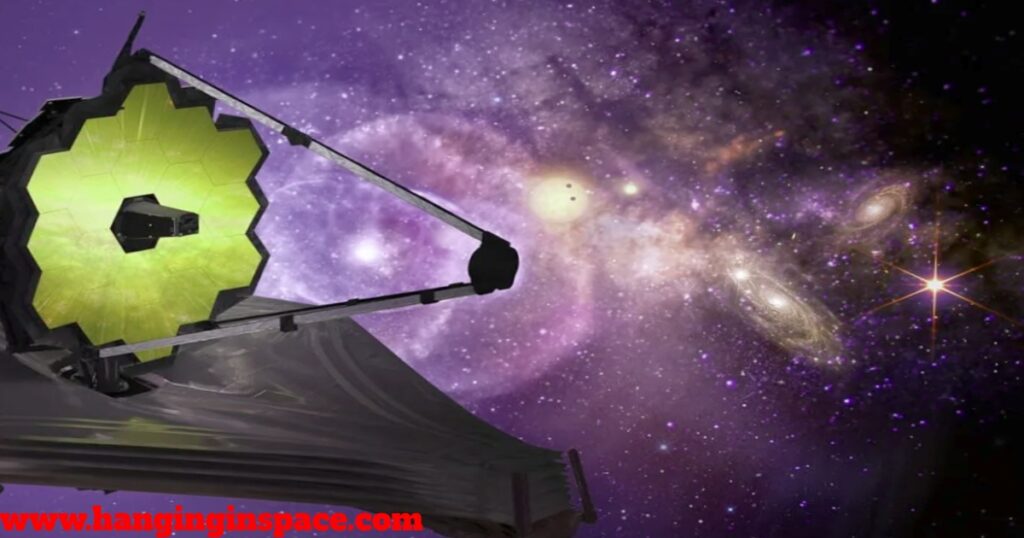The James Webb Space Telescope is the replacement for the renowned Hubble Space Telescope, and it is named for James E. Webb, the second administrator of NASA. It was launched from Europe’s Spaceport in French Guiana using an Ariane 5 rocket.
It is positioned at the second Lagrange point (L2), around 1.5 million kilometers from Earth. Its stable orbit enables unmatched cosmic studies.

The James Webb Space Telescope (JWST) is evidence of humanity’s unwavering quest for knowledge and our unquenchable curiosity about the cosmos. The JWST, which was launched on December 25, 2021, heralded a new era in space exploration and was the result of a historic partnership between NASA, the Canadian Space Agency (CSA), and the European Space Agency (ESA).
What are the Goals and Scientific Purpose of the James Webb Space Telescope (JWST)?
JWST’s main goal is to solve space mysteries, ranging from the origin of the first galaxies to the hunt for habitable exoplanets. With sophisticated sensors tailored for infrared observations, the JWST seeks to accomplish several important scientific goals, including:
Investigating the Early Universe:
The James Webb Space Telescope (JWST) aims to solve the puzzle of cosmic evolution by studying light from the early universe and looking deep into space. This will provide insights into the origin of stars, galaxies, and black holes in the early universe.
Investigating Exoplanets:
Thanks to the JWST’s potent equipment, scientists can examine exoplanets, planets that orbit stars outside of our solar system. They can examine the exoplanets’ atmospheres’ chemical makeup and look for indications of habitability.
Examining the Birth and Death of Stars:
The JWST’s infrared capabilities allow it to look through clouds of cosmic dust to observe the formation of stars and planetary systems. Astronomers seek to understand the life cycles of stars and the forces sculpting the universe by examining star-forming areas and the remains of supernova explosions.
What are the Discoveries of the James Webb Space Telescope (JWST)?
Even though the James Webb Space Telescope has just recently started conducting science, astronomers and space fans are excited about the revolutionary discoveries that will be made possible by it. The JWST has the potential to fundamentally alter our knowledge of the universe and our place in it.
Among its many goals are the discovery of the beginnings of galaxies, the mapping of the distribution of dark matter, the characterization of exoplanet atmospheres, and the observation of star birth. Here are some amazing discoveries by JWST:

Early Universe Galaxies:
JWST has peered deeper into the cosmos than ever before, capturing images of early galaxies that existed just a few hundred million years after the Big Bang. These observations challenge our current understanding of how galaxies formed so early in the universe’s history.
Atmospheric Analysis of Exoplanets:
JWST’s infrared capabilities allow it to analyze the atmospheres of exoplanets, revealing the presence of water vapor, methane, and other molecules. This information helps scientists assess the potential habitability of these distant worlds.
Interstellar Dust Composition:
JWST has detected the earliest-known carbon dust in galaxies, providing insights into the chemical evolution of the universe and the formation of stars and planets.
Supermassive Black Holes:
JWST has observed some of the most distant supermassive black holes ever detected, helping us understand how these giants formed and grew in the early universe.
Supermessive Black Hole-Powered Quasars:
Researchers have discovered a population of supermassive black hole-powered quasars using the James Webb Space Telescope, which may provide insight into how these objects expanded to sizes comparable to millions or billions of times the solar mass.
The little red spots of light that were identified as quasars are relatively small black holes that are in the transitional stage of becoming truly large supermassive black holes. This implies that this population of quasars may close a mass gap whose presence has baffled astronomers.
Clues to Star Formation:
By studying stellar nurseries in unprecedented detail, JWST is revealing the processes of star and planet formation, including the presence of protoplanetary disks around young stars.
Water on Exoplanets:
JWST has confirmed the presence of water vapor in the atmosphere of a hot gas giant exoplanet, opening doors for the possibility of water-based life on different types of planets.
Rings around Planetary Nebulae:
JWST has captured detailed images of the rings surrounding planetary nebulae, the remnants of dying stars, providing insights into the final stages of stellar evolution.
Read also: Latest Discoveries & Images by JWST
What is the difference between the James Webb Space Telescope (JWST) and the Hubble Space Telescope (HST)?
James Webb Space Telescope (JWST) Vs. Hubble Space Telescope (HST):
| Feature | James Webb Space Telescope (JWST) | Hubble Space Telescope (HST) |
|---|---|---|
| Launch Date | December 2021 | April 1990 |
| Location | Sun’s orbit, L2 point (1.5 million km from Earth) | Low Earth orbit (around 590 km from Earth) |
| Primary Light Observed | Infrared | Ultraviolet, visible, and near-infrared light |
| Strengths | Observing very faint and distant objects, studying early universe, piercing through dust clouds | High-resolution visible and ultraviolet light observations |
| Weaknesses | Limited ability to observe some closer objects, complex and expensive operation | Vulnerable to Earth’s atmosphere, limited infrared capabilities |
| Overall Goal | See the first stars and galaxies, understand cosmic evolution | Deep space observation across various wavelengths |
What is the current Location of the James Webb Space Telescope – JWST?
At the moment, the James Webb Space Telescope is located in the Virgo constellation. Right Ascension at this moment is 14h 08m 34s, and declination is +01° 45′ 43″. JWST is situated at the second Lagrange point, or L2, which is 1.5 million kilometers (1 million miles) from Earth in its orbit around the Sun. Since the James Webb Space Telescope is beyond the horizon, it cannot be seen.
Conclusion:
As JWST embarks on its mission to unveil the secrets of the cosmos, it heralds a new era of discovery and scientific advancement in astronomy.
